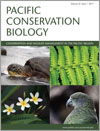
Pacific Conservation Biology
Volume 23 Number 1 2017
PCv23n1_OBObituary: Richard Wallace Braithwaite, 6 July 1947 to 1 October 2016
PC16026Managing dingoes on Fraser Island: culling, conflict, and an alternative
The management of predators requires balance between conservation and management aims. Fraser Island is an example where lethal control is used to manage human–dingo conflict. It is posited that traditional lethal control management strategies result in social instability of predator populations that may increase conflict.
PC16026 Abstract | PC16026 Full Text | PC16026PDF (596 KB) Open Access Article
PC16022Research challenges and conservation implications for urban cat management in New Zealand
In New Zealand, cats are a contentious topic – considered valued companion animals by some and introduced pests by others. This paper reviews current knowledge about domestic cats in urban New Zealand and makes suggestions for future research which may underpin future cat management legislation.
PC16022 Abstract | PC16022 Full Text | PC16022PDF (237 KB) Open Access Article
PC15029Prevalence of interactions between Hawaiian monk seals (Nemonachus schauinslandi) and nearshore fisheries in the main Hawaiian Islands
We determine the prevalence and characteristics of interactions between the Hawaiian monk seal (Nemonachus schauinslandi) and nearshore fisheries in the main Hawaiian Islands and examine impacts to the subpopulation
PC16011Mapping foraging habitat for migratory shorebirds in their Australian non-breeding grounds and prioritising sites for conservation and management
This study demonstrates methods to map important shorebird habitat using GIS to provide coastal zone managers a tool to enhance consideration of shorebird habitat within the management framework. Habitat values were assessed against a range of criteria and sites considered of high value that were heavily disturbed were prioritised for management.
PC16017Optimising camera trap deployment design across multiple sites for species inventory surveys
This paper investigates the effect of deployment time, camera array size and number of sites on detection of saxicoline mammals and varanid species in northern Australia and presents an analysis method for optimising decisions about how a limited number of cameras should be deployed across sites.
PC16025Introduced social bees reduce nectar availability during the breeding season of the swift parrot (Lathamus discolor)
The Swift Parrot Recovery Plan includes competition for nectar and pollen from introduced social bees as a threatening process. Here, we present the strongest evidence yet to support this theory. Bees consumed most nectar from the species of trees that are important to swift parrots during their breeding season.
PC16004Changes in the distribution of reports of the koala (Phascolarctos cinereus) after 16 years of local conservation initiatives at Gunnedah, north-west New South Wales, Australia
Revegetation for salinity control in Gunnedah Shire during the 1990s provided the opportunity to enhance koala habitat and increase local awareness. Surveys 16 years apart show that koalas became more widely reported in the agricultural areas of the shire, and the urban areas became the core of their reported distribution.
PC16013Floristics, dominance and diversity within the threatened Themeda grassy headlands of the North Coast Bioregion of New South Wales
In Themeda-dominated assemblages increasing biomass depth and a reduction in macropod grazing impact reduced plot species and trait richness and diversity. This was associated with a shift in assemblage identity. All three Themeda assemblages should be maintained in order to promote landscape diversity. Frequent fire is likely to cause homogenisation and loss of important components including listed threatened taxa.
PC16016Traditional ecological knowledge, shifting baselines, and conservation of Fijian molluscs
We used interviews with villagers of different generations to quantify the changes in commercially important shellfish, including giant clams (Tridacna spp.) in Fiji. Our results show that older generations remembered a more abundant ecosystem as well as larger clams. Younger generations however did not perceive this shift in an ecological baseline.
PC16023Habitat use by grey-crowned babbler, Pomatostomus temporalis, in urban and peri-urban environments
If key habitat structures are maintained, native fauna species may still inhabit urban environments after habitat loss. Grey-crowned babblers in Dubbo NSW behaved similarly in urban and peri-urban areas with small differences based on habitat availability. Managers of urban parklands should provide foraging substrates for a variety of woodland bird species.
PC16019An isolated population of the southern scrub-robin (Drymodes brunneopygia) in the Great Victoria Desert
This paper documents an isolated and fragmented population of the southern scrub-robin at the arid extreme of the species’ range. We discuss the species’ occurrence, habitat and vulnerability in the Great Victoria Desert.



